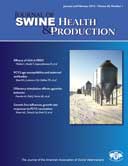Abstract:

Effect of olfactory stimulation during suckling on agonistic behavior in weaned pigs
María Fuentes, MVSc; Julio Otal, DBSc, PhD; María L. Hevia, DMV, PhD; Alberto Quiles, DMV, PhD; Francisco C. Fuentes, DMV, PhD
Complete article is available online.
PDF version is available online.
Objective: To determine the effect of olfactory stimulation during suckling on the weaned pig’s welfare.
Materials and methods: Six Control group sows and six treatment (Banana) group sows were used, each with 10 piglets. Treatment consisted of daily topical application of isoamyl acetate (banana scent) on the skin of the sows’ mammary glands during the 21 days of suckling. Preference of the piglets for the banana scent was tested with a V-maze at 4 and 21 days of age. After weaning, pigs were regrouped into groups of 10. For the Banana group, feeders were scented with isoamyl acetate for the 15 days after weaning. During the first 5 hours after regrouping, a video camera was used to record nonagonistic, aggressive, and submissive behaviors. Pigs were weighed on their day of birth and at 21 and 35 days of age. Feed consumed was weighed during suckling and for 15 days post weaning.
Results: Banana group pigs spent more time in the scented arm of the V-maze. They weighed more after weaning and had greater average daily gain (ADG) than the Control piglets (P < .05). During the postweaning observation period, Banana group pigs showed more nonagonistic and submissive behaviors and less aggressive behavior (P < .05). Feed consumption and ADG did not differ between treatment groups.
Implications: Treatment of the sows’ mammary glands with banana scent stimulates milk consumption. Treatment of the feeder with this same scent after weaning is associated with less aggressive behavior, but not with better growth parameters.
Keywords: piglet, olfactory stimulation before weaning, isoamyl acetate, behavior after weaning
![]() Cite as: Fuentes M, Otal J, Hevia ML, et al. Effect of olfactory stimulation during suckling on agonistic behavior in weaned pigs. J Swine Health Prod 2012;20(1):25-33.
Cite as: Fuentes M, Otal J, Hevia ML, et al. Effect of olfactory stimulation during suckling on agonistic behavior in weaned pigs. J Swine Health Prod 2012;20(1):25-33.
Search the AASV web site for pages with similar keywords.
